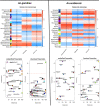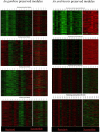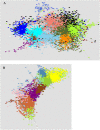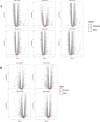Key gene modules and hub genes associated with pyrethroid and organophosphate resistance in Anopheles mosquitoes: a systems biology approach
- PMID: 38961324
- PMCID: PMC11223346
- DOI: 10.1186/s12864-024-10572-z
Key gene modules and hub genes associated with pyrethroid and organophosphate resistance in Anopheles mosquitoes: a systems biology approach
Abstract
Indoor residual spraying (IRS) and insecticide-treated nets (ITNs) are the main methods used to control mosquito populations for malaria prevention. The efficacy of these strategies is threatened by the spread of insecticide resistance (IR), limiting the success of malaria control. Studies of the genetic evolution leading to insecticide resistance could enable the identification of molecular markers that can be used for IR surveillance and an improved understanding of the molecular mechanisms associated with IR. This study used a weighted gene co-expression network analysis (WGCNA) algorithm, a systems biology approach, to identify genes with similar co-expression patterns (modules) and hub genes that are potential molecular markers for insecticide resistance surveillance in Kenya and Benin. A total of 20 and 26 gene co-expression modules were identified via average linkage hierarchical clustering from Anopheles arabiensis and An. gambiae, respectively, and hub genes (highly connected genes) were identified within each module. Three specific genes stood out: serine protease, E3 ubiquitin-protein ligase, and cuticular proteins, which were top hub genes in both species and could serve as potential markers and targets for monitoring IR in these malaria vectors. In addition to the identified markers, we explored molecular mechanisms using enrichment maps that revealed a complex process involving multiple steps, from odorant binding and neuronal signaling to cellular responses, immune modulation, cellular metabolism, and gene regulation. Incorporation of these dynamics into the development of new insecticides and the tracking of insecticide resistance could improve the sustainable and cost-effective deployment of interventions.
Keywords: Anopheles arabiensis; Anopheles gambiae; Hub genes; Insecticide resistance; Molecular markers.
© 2024. The Author(s).
Conflict of interest statement
The authors declare no competing interests.
Figures







Similar articles
-
Insecticide resistance status of Anopheles arabiensis in irrigated and non-irrigated areas in western Kenya.Parasit Vectors. 2021 Jun 26;14(1):335. doi: 10.1186/s13071-021-04833-z. Parasit Vectors. 2021. PMID: 34174946 Free PMC article.
-
The frequency of kdr and ace-1 alleles in Anopheles gambiae s.l. before and during indoor residual spraying (IRS) implementation and four years after IRS withdrawal in three districts in Atacora, Benin.Parasit Vectors. 2024 Mar 7;17(1):115. doi: 10.1186/s13071-024-06206-8. Parasit Vectors. 2024. PMID: 38454494 Free PMC article.
-
Current status of insecticide resistance among malaria vectors in Kenya.Parasit Vectors. 2017 Sep 19;10(1):429. doi: 10.1186/s13071-017-2361-8. Parasit Vectors. 2017. PMID: 28927428 Free PMC article.
-
Mutations in the voltage-gated sodium channel gene of anophelines and their association with resistance to pyrethroids - a review.Parasit Vectors. 2014 Oct 7;7:450. doi: 10.1186/1756-3305-7-450. Parasit Vectors. 2014. PMID: 25292318 Free PMC article. Review.
-
Distribution and insecticide resistance profile of the major malaria vector Anopheles funestus group across the African continent.Med Vet Entomol. 2024 Jun;38(2):119-137. doi: 10.1111/mve.12706. Epub 2024 Feb 2. Med Vet Entomol. 2024. PMID: 38303659 Review.
References
-
- Malaria eradication: benefits, future scenarios & feasibility - World | ReliefWeb. 2020. https://reliefweb.int/report/world/malaria-eradication-benefits-future-s.... Accessed 25 May 2023.
-
- Kenya - Malaria Indicator Survey 2020. https://microdata.worldbank.org/index.php/catalog/4188. Accessed 12 Oct 2023.
-
- Kamau L, Bennett KL, Ochomo E, Herren J, Agumba S, Otieno S, et al. The Anopheles coluzzii range extends into Kenya: Detection, insecticide resistance profiles and population genetic structure in relation to conspecific populations in West and Central Africa. Res Sq. 2024;:rs.3.rs-3953608. - PMC - PubMed
MeSH terms
Substances
LinkOut - more resources
Full Text Sources

